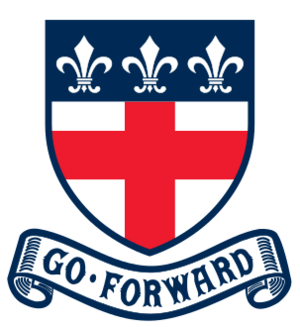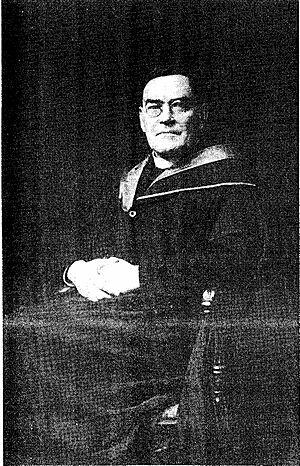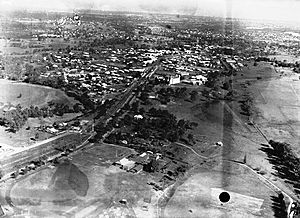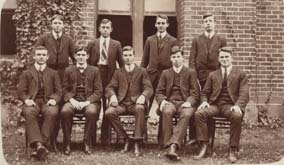Guildford Grammar School facts for kids
Quick facts for kids Guildford Grammar School |
|
|---|---|
 |
|

Guildford Grammar School, Terrace Road, in 1932
|
|
| Location | |
|
Australia
|
|
| Coordinates | 31°53′44″S 115°58′48″E / 31.89556°S 115.98000°E |
| Information | |
| Former name | The Church of England Grammar School |
| Official name | Guildford Grammar School |
| Type | State Registered Place |
| Reference no. | 2470 |
| Type | Independent co-educational primary and secondary day and boarding school |
| Motto | Go Forward |
| Religious affiliation(s) | Diocese of Perth |
| Denomination | Anglicanism |
| Established | 1896 |
| Founder | Charles Harper |
| Principal | Peter Allen |
| Staff | ~237 |
| Years | K–12 |
| Enrolment | ~1,097 (2019) |
| Area | 80 hectares (198 acres) |
| Campus type | Suburban |
| Colour(s) | Navy blue and white |
| Affiliations |
|
| Alumni | Old Guildfordians |
Guildford Grammar School, also known as Guildford Grammar or GGS, is an independent school in Guildford, Western Australia. It is located in a suburb of Perth, Western Australia. The school is for both boys and girls (co-educational) and teaches students from primary to secondary school. Students can attend as day students or live at the school as boarders.
The school started as a boys-only school. In 2019, it became co-educational for younger students (Kindergarten to Year 6) and some senior years (Years 7, 8, and 11). Since 2019, Guildford Grammar School has been fully co-educational. It also offers boarding for girls in the Senior School since 2020.
Guildford Grammar School is a member of important school groups like the Public Schools Association.
Contents
School History
Guildford Grammar School began in 1896. It was started by Charles Harper, an important person in Western Australia. He opened the school in the billiard room of his home, Woodbridge House. The first headmaster was Frank Bennett. Harper wanted to create a school like the famous "public schools" in England.
In 1900, the school moved to its current location near the Swan River. This site is about 15 kilometers from the center of Perth. The school was first called The Church of England Grammar School. In 1905, it helped create the Public Schools Association (PSA) with other schools.
The school started with only 14 students. By 1910, it had over 100 students. The Trustees of the Church of England took over the school. Canon Percy Henn became the Headmaster.
In 1914, the beautiful Chapel of St Mary and St George was officially opened. Also, the preparatory school (for younger students) was founded. It was originally only for boys but is now co-educational.
During World War II in 1942, the senior school students and staff moved to Fairbridge Farm School for 18 months. This was a safety measure during the war.
The Guildford Grammar School Foundation was set up in 1974. This foundation helps the school financially. It also provides scholarships and bursaries to help students attend. In 2019, the school had 1,097 students. It could also house 148 boarding students.
School Coat of Arms
The school's coat of arms was inspired by the dedication of the chapel in 1914. The arms show a red cross on a white shield, which is the cross of St George. Above it are three fleur de lys (a lily symbol) on a dark blue background, representing St Mary. The school's motto, "Go Forward," is written below the arms.
School Leaders
Here are the people who have been the Principal (or Headmaster) of Guildford Grammar School:
| Ordinal | Headmaster | Term begin | Term end | Time in office | Notes |
|---|---|---|---|---|---|
| 1 | Frank Bennett | 1896 | 1898 | 1–2 years | |
| 2 | Alex Gillespie | 1899 | 1903 | 3–4 years | |
| 3 | William Corr | 1904 | 1909 | 4–5 years | |
| 4 | Percy Henn | 1910 | 1924 | 13–14 years | |
| 5 | Philip Hinckley | 1925 | 1927 | 1–2 years | |
| 6 | Robert Freeth | 1928 | 1949 | 20–21 years | |
| 7 | Peter Thwaites | 1950 | 1956 | 5–6 years | |
| 8 | David Lawe Davies | 1957 | 1978 | 20–21 years | |
| 9 | John Moody | 1979 | 1996 | 16–17 years | |
| 10 | Kim Walton | 1997 | 2002 | 4–5 years | |
| 11 | Robert Zordan | 2003 | 2010 | 6–7 years | |
| 12 | Stephen Webber | 2011 | 2019 | 14–15 years | |
| 13 | Anne Dunstan | 2020 | 2022 | 5–6 years | |
| 14 | Peter Allen | 2023 | incumbent |
School Campus
Guildford Grammar School is on a large campus of about 80 hectares (200 acres). It is located by the Swan River. The campus has many buildings and sports areas for students. Some buildings are very old and important, like the chapel. Most buildings and sports fields are named after people important to the school's history.
In 2005, the school started a big project called the "One Campus Project." This project improved the school's playing fields and other areas. It included building a new hockey pitch, another football oval, and new tennis courts. They also built a new sports pavilion.
School Chapel
The school chapel is called the Chapel of St Mary and St George. It has a special architectural style called Federation Gothic. Headmaster Canon P.U. Henn first suggested building it. Cecil Oliverson helped pay for it. The chapel is a heritage-listed building. It has a lot of English Oak wood inside. It also has a Bible called the Windsor Bible, which was a gift from Queen Elizabeth II.
Student Life
Guildford Grammar School offers many extra activities for students. These include sports, music, arts, and cadets. The school also has boarding facilities for students who live far away.
The cadet program at Guildford started in 1904. It is part of the Australian Army Cadet Corps.
Students can also join the national Tournament of Minds competition. Guildford has done well in this competition, often reaching state finals.
Academic Studies
The school offers many subjects for students to study. Students can earn awards for their academic achievements. These include academic colors, subject awards, and the dux award for the top student.
Guildford offers several scholarships based on how well students perform academically. To get a scholarship, students take an exam and submit a portfolio of their work. Shortlisted students also have an interview with the headmaster.
Some scholarships include:
- D'Arcy Slater Scholarship: Awarded yearly to a student entering Year 7. It covers all tuition fees.
- Council Scholarships: Academic scholarships for students under 13 entering Year 7. They cover 25% to 50% of tuition fees for six years.
- Harry Campbell Pope Scholarships: For students entering Year 7. They cover 25% to 50% of tuition fees for six years.
- Calder Crowther Scholarship: Awarded every two years to day students from nearby government schools. It covers 50% of tuition fees from Years 7 to 12.
The school also offers scholarships for music and choir.
Boarding at School
When Guildford Grammar School first opened, it was a day school. Boarding was later introduced for students in Years 6 to 12. The school can house 130 boarding students.
All boarders live in special boarding houses. They live with House-masters, House-mothers, and boarding assistants. On weekends, staff and older students organize different activities for boarders. Older boarders also play sports on Saturday mornings.
House System
Guildford Grammar School has a "house system" in the senior school. There are eight houses, each named after important people connected to the school or Western Australia. For example, one house is named after Canon Percy Henn, a former headmaster. Another is named after James Stirling, who helped settle Western Australia.
In the junior school, there are four houses. These are simply named North, East, South, and West.
The eight senior school houses are Henn's, School, Stirling, Harper, Bennett, St. George's, Woodbridge, and Freeth House. Each house has smaller mentor groups for each year level. A mentor and a Head of House look after each group. The students in each house are led by a House Captain.
The senior school houses compete in three main areas:
- Sport: For the Cock House Cup.
- Culture: For the Centenary Cup.
- Academics: For the John Gladstones' Cup.
The Council Shield is given to the house that performs best overall in these three competitions.
Performing Arts and Debating
Students in the senior school can learn musical instruments during class time. There are also music groups like the senior choir and guitar ensemble. Music is a required subject for all students from Kindergarten to Year 6. Older students can continue music studies.
The drama program at the school often puts on big productions. Past shows include Jesus Christ Superstar and Les Miserables. Famous actor Heath Ledger attended Guildford Grammar School. He had his first acting experiences there, playing Peter Pan at age 13.
Debating and public speaking are also part of the school's extra activities. Guildford Grammar School competes in the Western Australian inter-school debating competition.
School Sports
Guildford Grammar School was one of the first members of the Public Schools Association (PSA) in 1905. It also joined the Independent Primary School Heads of Australia (IPSHA) in 1968. The school competes in inter-school sports within both of these organizations.
Guildford has won many trophies in different sports over the years. They have won Swimming (18 times), Cricket (15 times), Athletics (12 times), Rugby (8 times), Football (6 times), and Rowing (Head of the River) (6 times).
Recently, Guildford won the Alcock Cup (Football) in 2015 and the Darlot Cup (Cricket) in 2018.
PSA Sports Wins
Guildford Grammar has won the following PSA championships:
- Athletics (12 wins) – 1905, 1906, 1907, 1918, 1926, 1930, 1940, 1945, 1946, 1947, 1949, 1950
- Basketball (4 wins) – 1981, 1983, 1991, 1993
- Cricket (16 wins) – 1915, 1917, 1919, 1920, 1921, 1935, 1936, 1937, 1946, 1959, 1968, 1969, 1971, 1982, 1986, 2018
- Cross Country (1 win) – 1982
- Football (7 wins) – 1905, 1935, 1936, 1938, 1946, 1958, 2015
- Golf (6 wins) – 2009, 2011, 2012, 2014, 2017, 2018
- Rowing (3 wins) – 1992, 2001, 2013
- Rugby (8 wins) – 1980, 1981, 1983, 1984, 1985, 1986, 1987, 1994
- Soccer (2 wins) – 1990, 1994
- Swimming (18 wins) – 1905, 1916, 1920, 1922, 1951, 1952, 1959, 1960, 1961, 1962, 1963, 1966, 1996, 1997, 1999, 2000, 2001, 2002
- Tennis (1 win) – 1982
- Water Polo (1 win) – 1998
Famous Former Students
Students who have graduated from Guildford Grammar School are called "Old Guildfordians." They can join the Old Guildfordians Association, which helps former students stay connected. This group also supports the school, especially by providing scholarships.
The Old Guildfordians Mundaring Hockey Club is a hockey club for men and women. It is based in the Guildford/Mundaring area. Many members of the club are former students, but you don't have to be an Old Guildfordian to join.
Notable Alumni
Here are some well-known people who went to Guildford Grammar School:
- Corey Adamson, former baseball player
- Piers Akerman, newspaper writer
- Sir Francis Burt, former Chief Justice and Governor of Western Australia
- Ben Carlin, famous for traveling around the world in a car that could also go on water
- A.J. Carter, film producer and director
- John Day, former politician
- Andrew Denton, television presenter and producer
- Heath Ledger, Academy Award-winning actor
- Seaforth Mackenzie, author
- David Malcolm, former Chief Justice of the Supreme Court of Western Australia
- Tom Moody, international cricketer and coach
- Paul Murray, journalist and radio commentator
- Kevin O'Halloran, Olympic gold medalist in swimming
- Arnold Potts, a military commander during World War II
- Alex Rance, Australian rules footballer
- John Steffensen, national sprinter
- Randolph Stow, poet and author
- Carl Vine, musician and composer
See also
- List of schools in the Perth metropolitan area
- List of boarding schools in Australia





